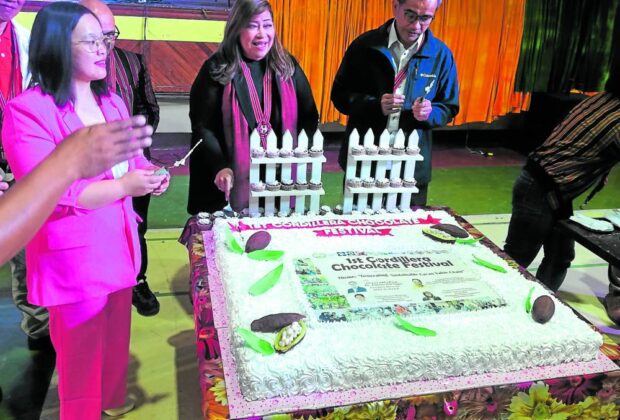Cordillera cacao takes centerstage at festival on Valentine

FIRST SLICE Dulche Chocolates manager Eva Ritchelle Padua (left) leads the ceremonial slicing of a chocolate cake dedicated to the first Cordillera Chocolate Festival held on Feb. 14 at Benguet
State University in La Trinidad, Benguet. —CONTRIBUTED PHOTO
LA TRINIDAD, BENGUET—Chocolates produced by local cacao growers and entrepreneurs were displayed at a local university on Valentine’s Day on the sidelines of the Cordillera’s first chocolate festival that promotes the fledgling cacao industry in the region.
“Love is in the air because we have chocolates,” said Armi Lopez Garcia, the Visayas-based president of the Philippine Cacao Industry Association Inc. (PCIA), who spoke at the festival’s opening program at the Benguet State University.
Lopez also runs a Cebu-based chocolate company.
The Philippine Statistics Authority placed the Cordillera’s production last year at only 20.5 metric tons (MT) from January to March and 11.78 MT from April to June, which were grown by small cacao farms in the provinces of Apayao, Benguet, Kalinga and Mountain Province.
But growing cacao in high-altitude farms in the region intrigues the PCIA, Garcia said, because of notions that cold weather could produce special cocoa bean flavors.
The festival was organized by Dulche Chocolates, a manufacturer from Benguet, which has been expanding after its dark chocolate bars drew a small following in local bazaars and trade fairs.
Separate industry
Benguet Gov. Melchor Diclas said it made sense for his province, which is known for growing high-value salad vegetables, strawberries and arabica coffee, to harness a separate cacao industry. Vegetables are Benguet’s cash crop. It supplies 80 percent of the daily vegetable demand in Metro Manila and other Luzon provinces.
Apayao currently has the biggest cacao farm area (24 hectares) that produced 20 tons of dried cacao beans as of 2022, followed by Kalinga (15 ha that harvested 10 tons), Benguet (10 ha, 4 tons), and Mountain Province (4 ha, 2 tons).
But the Cordillera represents only 1 percent of Philippine cocoa harvests.
“Davao Region contributes 80 percent of the national cacao production, having 19,769 ha (of land planted with cacao in 2015. The rest of Mindanao contributes 10 percent, while the remaining 10 percent is being shared by Luzon and the Visayas,” according to the 2017–2022 Philippines Cacao Industry Roadmap.
Garcia said growers in the Cordillera would need to harvest a national target of 2 kilograms of dried beans per tree per year to make up for a shortfall because growers all over the country could only generate 0.77 grams of beans per tree per year.
Advantage
According to the roadmap, the country has “a competitive advantage on cacao production, and its 2 million ha of coconut farms are “ideal for cacao intercropping.”
It added: “The first cacao in Asia was planted in the Philippines in 1670, while commercial farms developed in the 1950s. Production levels reached 35,000 MT by 1990. However, production started to decline due to several factors, such as weather and climatic conditions, pest and disease infestations, and aging trees.”
Garcia said the country’s cocoa industry had developed its own quality control system and branding mechanisms to make sure top-quality Filipino chocolates can compete in the world market.
Research, dev’t
Cocoa growers are also immersed in research and development to improve the trade, Garcia said.
For instance, Dulche manager Eva Ritchelle Padua heads the government-financed Project Sweet PH-C, which sets out to standardize techniques for processing mountain-grown cacao. Padua distributed a manual for cocoa production to farmers who attended the festival.
READ: Two Filipinos named National Geographic Young Explorers
Garcia said the PCIA had been developing a YouTube channel devoted to expert tutorials on planting and sustaining cacao trees and had reached out to the Department of Tourism for a video that markets cocoa farms as part of the agency’s farm tourism campaign.
Popularizing Filipino cocoa has become essential, not only to tap a new market but also to encourage young Filipinos to take over cocoa farms tended by older farmers, she said.